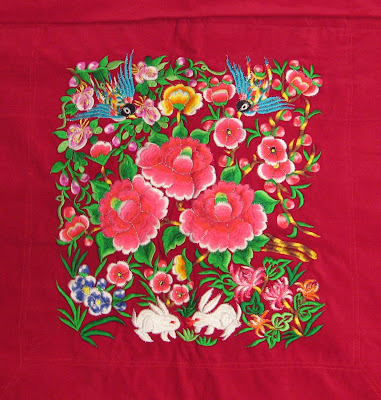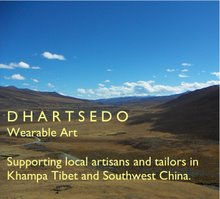 Dhartsedo showcases the unique tailoring, artistry and crafts of Khampa Tibet and Southwest China. Click on the map to enlarge.
Dhartsedo showcases the unique tailoring, artistry and crafts of Khampa Tibet and Southwest China. Click on the map to enlarge.
Dhartsedo: Wearable Art from Khampa Tibet and Southwest China
 Dhartsedo showcases the unique tailoring, artistry and crafts of Khampa Tibet and Southwest China. Click on the map to enlarge.
Dhartsedo showcases the unique tailoring, artistry and crafts of Khampa Tibet and Southwest China. Click on the map to enlarge.
Guza Baby Carriers


In Tibetan culture, infants are often strapped to their mother’s back for long periods during the day, and women from many areas sew and embroider ornate baby carriers for this purpose. This colourful baby carrier comes from the Chinese/Tibetan border town of Guza, traditionally a Gyarong Tibetan community. The two long straps cross at the front and wrap around the back to tie again at the front.
Gala yak hair handspun/woven throw


Gala village is a remote Tibetan community in the mountains on the border of the Garze Tibetan Autonomous Prefecture in Sichuan Province and the Deqin Tibetan area in Yunnan Province, China. This throw is spun from yak hair, which is woven in thick strips then sewn together. These throws are staple household items in the Gala and surrounding villages.
Gala goat hair handspun/woven throw

Gala village is a remote Tibetan community in the mountains on the border of the Garze Tibetan Autonomous Prefecture in Sichuan Province and the Deqin Tibetan area in Yunnan Province, China. This throw is spun from goat wool, and woven in thick strips which are sewn together and finished off with a colorful woven edging. In this area of Tibet, white goat wool is more rare than black yak hair, and house guests always have a white blanket laid over their bed as a token of their hosts’ compliments.
Danba Woven Sashes
Rissa Leather Cut-Out Saddle Satchel


Rissa is a remote herding village on the Lhagong grasslands in the Garze Tibetan Autonomous Region in western Sichuan province, China. This satchel was cut from hand-treated yak leather and crafted in a traditional saddlebag style, but the straps were fixed at the side so that it can be used with greater ease as a shoulder bag.
Shamalong Nomad Slingshots
Shamalong Handwoven Wool Money Belt
Shamalong Sewing Kits

Shamalong is a herding village in Lhagong county in the Garze Tibetan Autonomous Region in western Sichuan province, China. This traditional sewing kit is made of hand-treated yak leather, and can be worn dangling at the waist or hung in a convenient place. Thread or yarn is kept in the smaller pocket, and needles kept in the longer one. It is made by nomadic herder artisans.
Shamalong Nomad Rain Hats

Shamalong is a herding village in Lhagong county in the Garze Tibetan Autonomous Region in western Sichuan province, China. These hats are made of locally handmade wool felt which is both warm and water resistant. The conical shape means the water runs down the hat, keeping the face dry in a rainstorm.
Shamalong Monk Bowl Covers (with bowls)

Traditionally, monks would carry their bowls in these covers when travelling from place to place. They are woven around a simple reed frame using yak hair and sheep wool. The Tibetan bowls feature decoration of auspicious symbols and a curved lip suitable for drinking tea. These bowl covers are made by artisans from Shamalong, a herding village in Lhagong county in the Garze Tibetan Autonomous Region in western Sichuan province, China.
Shamalong Nomad Bags
Shamalong Felt Boots
Brocade Lined Mens Vest (Side Fastening)
Brocade Lined Mens Jackets (Side Fastening)


This side-fastening brocade-edged jacket is the signature garment of the ’Khampa Hanzi’, the dashing and fearless menfolk of Kham, the easternmost of Tibet’s traditional three provinces. This garment has extra long sleeves to create an exaggerated silhouette on horseback and to do away with the need for hand gloves in cold weather. This jacket was made by a tailor named Rinchen from Dhartsedo (Kangding), the prefectural capital of the Garze Tibetan Autonomous Region in western Sichuan province, China.
Sheepskin Brocade Vest
Drango Handspun/Woven Woolen Jacket (Natural)

This jacket was made by a disabled tailor named ___ from the the Tibetan town of Drango in the Garze Tibetan Autonomous Region in the west of Sichuan province, China. The main woolen fabric was spun, woven and washed by a retired herdswoman using the wool collected from her own sheep. It was woven on a simple wooden loom. The edging – a coarse woolen fabric called ‘chuk’ – is imported from central Tibet and features auspicious symbols and patterns.
Drango woolen jacket with cut-out detailing

This jacket was made by a nomadic tailor/artisan named Tseren Wengjia from the Tibetan town of Drango in the Garze Tibetan Autonomous Region in the western of Sichuan province, China. The main fabric is a wool felt imported from central Tibet and the swirling felt cut-out designs are a technique Tseren learned from his father.
Brocade Lama Jacket
Subscribe to:
Comments (Atom)















